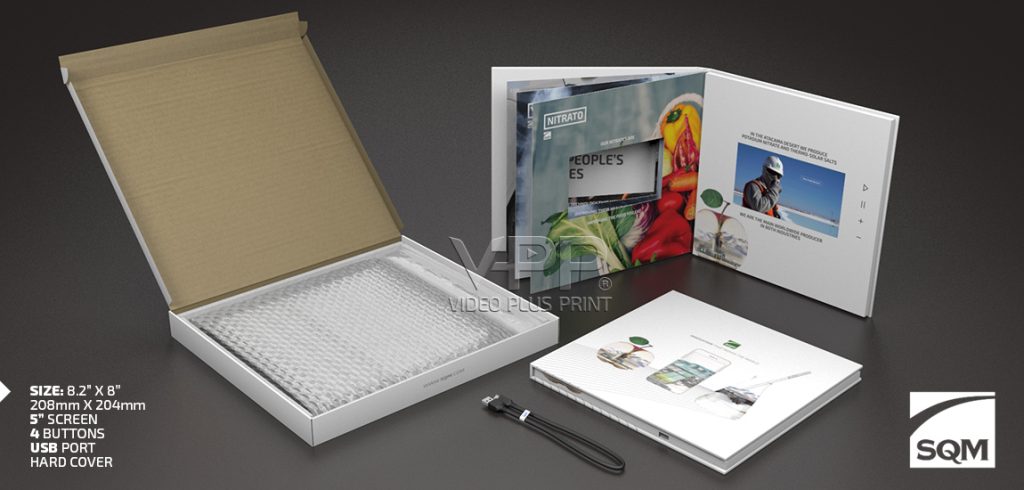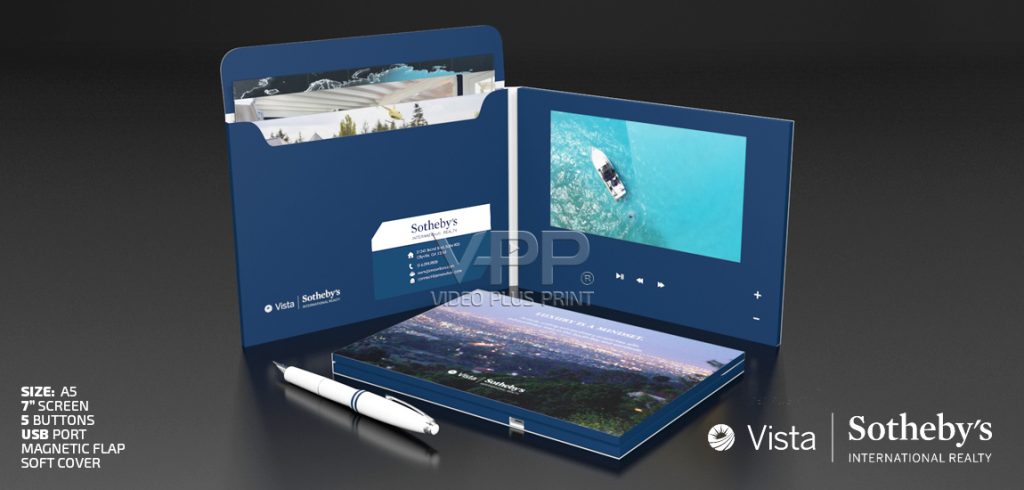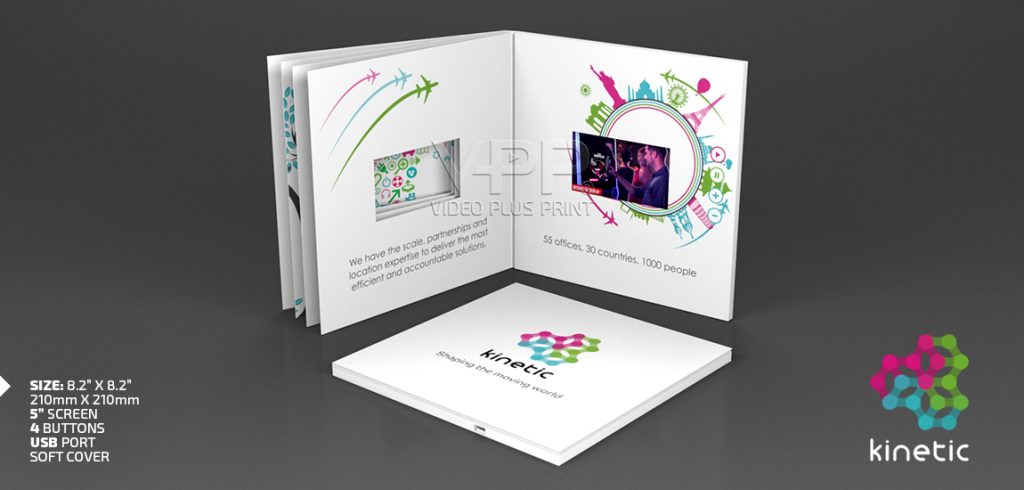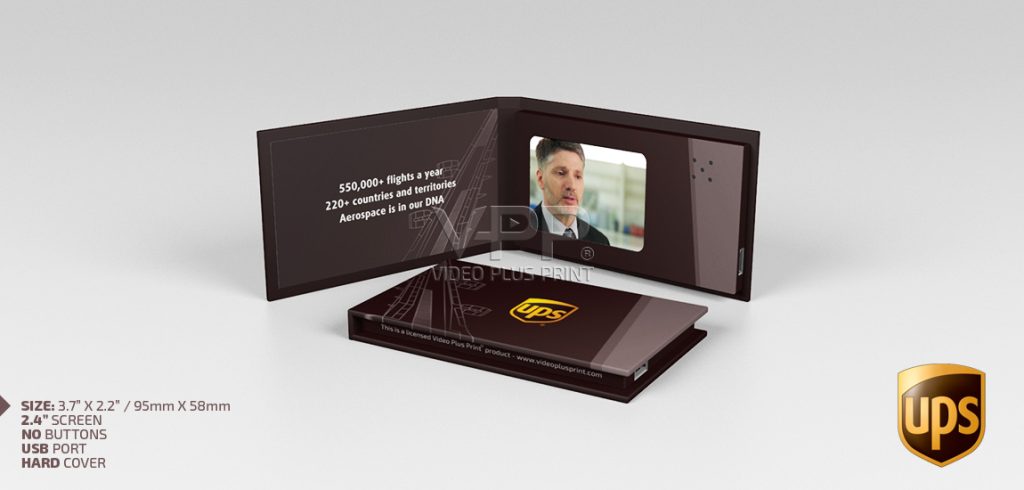Understanding the Core Difference of Video Brochures & Video Boxes
When comparing video brochures vs video boxes, it’s important to know how each format functions. A video brochure opens like a printed booklet with an embedded LCD screen. A video box, on the other hand, integrates the same technology inside a rigid box that can hold physical products or gifts.
While both merge print with video, they differ in purpose. A video brochure communicates a message directly through storytelling and visuals. A video box creates a tactile, immersive unboxing moment.
The right choice depends on how your brand wants to connect—with portability or presentation power.
Key Takeaways
Video brochures are designed for presentation and portability, while video boxes deliver unboxing experiences.
Both formats use embedded screens but serve different marketing goals.
Video boxes add depth and luxury; brochures emphasize mobility and distribution efficiency.
Cost, audience, and campaign purpose determine which format fits best.
Combining both creates layered marketing experiences that enhance engagement.
When to Choose a Video Brochure
Video brochures are ideal for one-on-one presentations, mail campaigns, and trade shows. Their slim profile allows easy distribution while maintaining a professional look.
These brochures typically come in sizes like A5 or A4, with screens ranging from 4.3 to 10 inches. They work best when the goal is to communicate quickly and visually.
A well-designed brochure highlights your brand message without overwhelming the viewer, making it perfect for sales pitches, event invitations, and direct marketing efforts.
When to Choose a Video Box
A video box combines storytelling with physical presentation. It’s perfect for high-value promotions, luxury product launches, or client gifting.
Boxes can hold merchandise, product samples, or event materials, with video content playing as the lid opens. This immersive reveal adds emotion to the experience.
For premium campaigns, a video box transforms a simple delivery into a brand moment that clients remember long after opening.
Comparing Size, Structure, and Impact
The video box vs video brochure comparison starts with structure. A brochure is thin and lightweight, while a box is rigid and spacious.
Video brochures excel in portability and scale. Video boxes excel in luxury appeal and interactivity. The brochure delivers simplicity; the box delivers spectacle.
Choose a brochure for volume distribution and cost-efficiency. Choose a box when the presentation itself is part of the story.

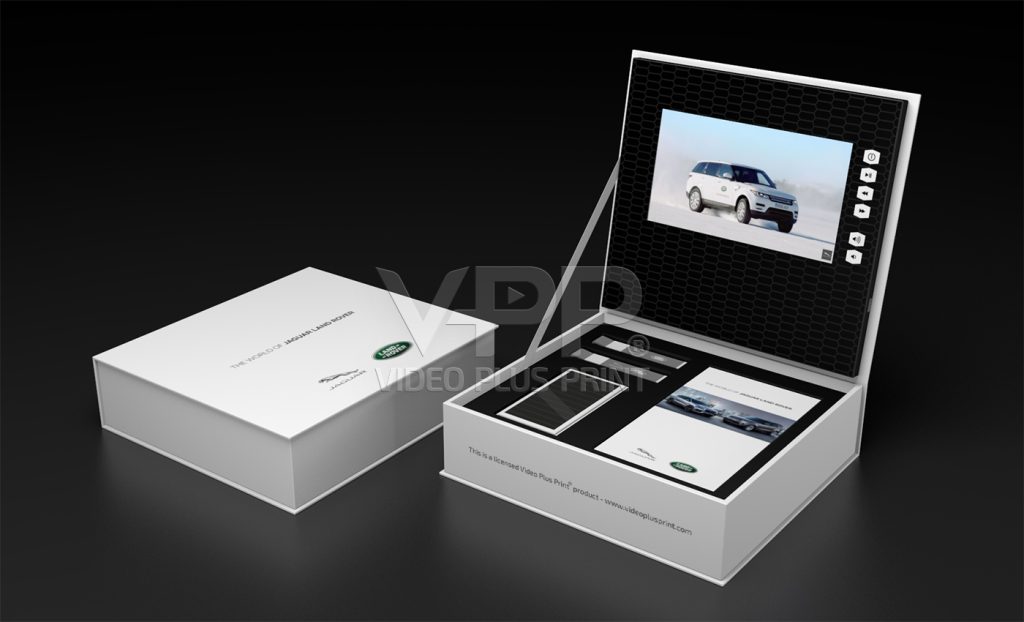
The Role of Video in Both Formats
Both formats share the same technology—high-resolution LCD or IPS screens. However, the way video integrates differs.
A video brochure focuses on content clarity and quick messaging. The box emphasizes experience and emotion. Brands often use storytelling videos in brochures and cinematic intros in boxes.
The same video file can be used in both, but editing and presentation should suit each format’s purpose.
Cost Considerations and ROI
Budget plays a major role in deciding between video brochures and video boxes. Brochures are more cost-effective per unit and ideal for wide distribution.
Video boxes, being larger and more complex, cost more to produce and ship. However, they deliver a higher perceived value and better emotional response.
If your goal is awareness, use brochures. If your goal is retention or premium gifting, choose boxes. Each offers measurable ROI when used strategically.
Shipping and Storage Differences
Shipping logistics vary between the two. Video brochures are lightweight and can be mailed easily in padded envelopes.
Video boxes are heavier and often require protective packaging. Their bulk increases shipping costs but adds to perceived importance when received.
For global campaigns, brochures simplify fulfillment. For selective gifting, boxes enhance the perceived exclusivity of the delivery.
Combining Both Formats for Maximum Effect
Some brands successfully combine both formats within one campaign. For instance, a brochure might introduce a product, while a video box delivers the product itself.
This layered experience builds anticipation and emotional depth. A coordinated approach enhances storytelling and creates memorable brand interactions.
Using both formats also helps segment audiences—mass distribution with brochures, exclusive engagement with boxes.
Customization Options for Both
Both video brochures and video boxes support extensive customization. You can adjust screen size, memory, battery capacity, and housing materials.
Boxes often include foam inserts or magnetic closures for secure product placement. Brochures allow printed textures, spot UV finishes, and button layout customization.
The best designs align with your brand’s visual language, ensuring a cohesive look across print, video, and physical packaging
Durability and Presentation Quality
Video box marketing emphasizes sturdiness and long-term reuse. Many recipients keep video boxes as keepsakes or storage items.
Video brochures, though slimmer, are designed for multiple plays but may show wear with heavy handling. Both formats use reinforced materials for protection during shipping.
If durability and longevity matter most, the video box holds the advantage.
Environmental and Practical Considerations
Both products can be produced using eco-conscious materials. Recyclable paperboard, rechargeable batteries, and energy-efficient screens minimize waste.
For large campaigns, lighter brochures reduce carbon footprint through smaller shipping volumes. Boxes, though bulkier, can be reused or repurposed for added life cycle value.
Balancing sustainability with presentation goals ensures responsible marketing impact.
FAQs Video Brochures VS Video Boxes
Q: What’s the main difference between a video brochure and a video box?
A: A video brochure is a thin booklet-style with an LCD meant for direct messaging, while a video box is a rigid container combining video LCD screen with a gift or product presentation in the tray of the box.
Q: Which format works better for product launches?
A: Video boxes excel for product launches due to their unboxing appeal. They create excitement and emphasize the premium nature of the product.
Q: Are video boxes more durable or premium?
A: Yes. Video boxes use thicker materials and protective interiors, making them more durable and luxurious than video brochures.
Q: How do shipping and storage differ between the two?
A: Video brochures are lightweight and mail-friendly. Video boxes require more protection and have higher shipping costs due to their size.
Q: Which is more cost-effective for B2B campaigns?
A: Video brochures are more cost-efficient for bulk orders, making them ideal for B2B outreach and trade show giveaways.
Q: Can I combine both in a single marketing kit?
A: Yes. Many brands pair brochures for pre-launch promotion with video boxes for final product deliveries or exclusive gifting.
Q: Do both formats support the same video quality?
A: Yes. Both use LCD or IPS screens supporting resolutions from 480p to 1080p depending on configuration.
Q: What are the typical screen sizes available?
A: Common options include 4.3-inch, 5-inch, 7-inch, and 10-inch displays, depending on available space and design.
Q: Can I customize the internal design of a video box?
A: Absolutely. Foam inserts, compartments, and custom colors can be tailored to match your product and brand style.
Q: How do I upload videos to either format?
A: Videos are added via USB connection. All units allow easy upload, replacement, or updates without special software.
Q: Are video boxes reusable?
A: Yes. Many clients repurpose video boxes for storage or reuse them as premium packaging for other items.
Q: Which format has longer battery life?
A: Both can hold similar battery capacities, but larger boxes often include higher-capacity batteries for extended playback.
Q: Can I add sound or motion sensors?
A: Yes. Both formats can include motion sensors, sound activation, or magnet-triggered playback for added interactivity.
Q: Which option is better for luxury branding?
A: Video boxes lead in luxury presentation, making them ideal for premium clients or exclusive promotions.
Q: Are video brochures better for trade shows?
A: Yes. Their compact, lightweight design makes them easy to hand out at trade events without logistical issues.
Q: How do I choose between LCD and IPS screens?
A: IPS screens offer brighter colors and wider viewing angles, while LCD screens are more affordable for large runs.
Q: What’s the average production time for each format?
A: Video brochures typically take 3–5 weeks, while video boxes may require 4–5 weeks due to assembly and packaging and QC procudures.
Q: Can both formats include branding elements on the exterior?
A: Yes. Both can feature printed artwork, embossing, or foil stamping for a customized look.
Q: Are there minimum order quantities?
A: Most manufacturers require a minimum of 50-100 units for either format, with discounts for higher quantities.
Q: How do I decide which format fits my campaign?
A: Consider your audience and intent. Choose video brochures for reach and simplicity, and video boxes for depth, emotion, and luxury appeal.





